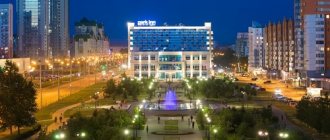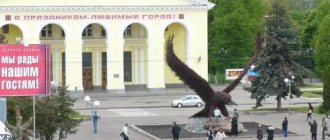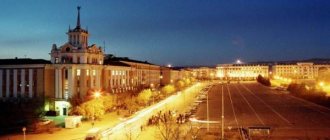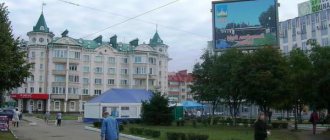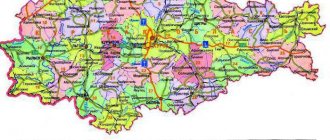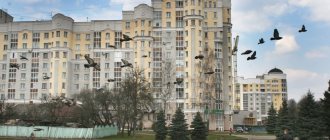This term has other meanings, see Polar (meanings).
| City Zapolyarny Flag | Coat of arms |
| A country | Russia, Russia |
| Subject of the federation | Murmansk regionMurmansk region |
| Municipal district | Pechenga |
| urban settlement | Zapolyarny |
| Coordinates | 69°25′00″ n. w. 30°48′00″ E. d. / 69.41667° s. w. 30.80000° E. d. / 69.41667; 30.80000 (G) [www.openstreetmap.org/?mlat=69.41667&mlon=30.80000&zoom=12 (O)] (Z)Coordinates: 69°25′00″ N. w. 30°48′00″ E. d. / 69.41667° s. w. 30.80000° E. d. / 69.41667; 30.80000 (G) [www.openstreetmap.org/?mlat=69.41667&mlon=30.80000&zoom=12 (O)] (I) |
| Based | 1956 |
| City with | 1963 |
| Square | 6[1]km² |
| Center height | 116 |
| Population | ↘15,211[2] people (2016) |
| Names of residents | polar inhabitants, polar inhabitant[3] |
| Timezone | UTC+3 |
| Telephone code | +7 81554 |
| Postcode | 184430 |
| Vehicle code | 51 |
| OKATO code | [classif.spb.ru/classificators/view/okt.php?st=A&kr=1&kod=47215503 47 215 503] |
| Official site | [www.zapadmin.ru/admin.ru] |
| Zapolyarny Moscow |
| Murmansk Nickel Zapolyarny |
Audio, photo and video
on Wikimedia Commons
K: Settlements founded in 1956
Zapolyarny
- a city (since 1963) in the Pechenga district of the Murmansk region of Russia. The center and only populated area of the urban settlement Zapolyarny. It is located 150 km northwest of Murmansk[4].
By Order of the Government of the Russian Federation dated July 29, 2014 No. 1398-r “On approval of the list of single-industry towns,” the city was included in the category “Single-industry municipalities of the Russian Federation (single-industry towns) in which there are risks of worsening the socio-economic situation”[5].
Population - 15,211[2] people. (2016).
Story
The first settlement on the site of the city was founded in 1955 by geologists during the construction of the Zhdanovsky mining and processing plant on the basis of the Zhdanovsky copper-nickel deposit, discovered in 1946. The founding date of the city is considered to be May 4, 1955. Rebuilt by the Pechenganikelstroy trust and Leningrad Komsomol members[6]. On April 20, 1956, the settlement at the plant was included in the registration data and received the name “Zapolyarny” (since it was located beyond the Arctic Circle), and by the Decree of the Presidium of the Supreme Soviet of the RSFSR dated May 30, 1957, Zapolyarny was classified as a workers’ settlement.
By the decision of the Murmansk Regional Executive Committee of July 16, 1959, the village at the Zhdanovskaya station of the Kola-Pechenga railway was included in the boundaries of the working village of Zapolyarny.
By decree of the Presidium of the Supreme Soviet of the RSFSR dated February 1, 1963, the working village of Zapolyarny was transformed into a city of regional subordination.
The second settlement that arose during the development of the Zhdanovskoye field was the village of Pilguyarvi
, renamed on March 22, 1958 to the village of
Gorny
. By the decision of the Murmansk Regional Executive Committee of July 16, 1959, it received the status of a workers' village, with subordination to the Polar Council. According to the 1959 census, the population of Gorny was 2,398 people[7]. By the decision of the Murmansk Regional Executive Committee of March 30, 1967, the working village of Gorny was included within the boundaries of Zapolyarny[8].
Rice. 1. Number of permanent population of the city of Zapolyarny for 1999 - 2010.
Population dynamics over the past 10 years (relative to 1999) show a stable annual decline in the population of the city of Zapolyarny.
If the change, namely growth, in the city’s population in Soviet times occurred mainly due to the mechanical movement of the population, then in recent years the population has changed for two reasons: natural decline and migration population decline (Fig. 2).
Excerpt characterizing Zapolyarny
“Be quiet, Petya, what a fool you are!” “I’m not a fool, but those who cry over trifles are fools,” said Petya. – Do you remember him? – after a minute of silence Natasha suddenly asked. Sonya smiled: “Do I remember Nicolas?” “No, Sonya, do you remember him so well that you remember him well, that you remember everything,” Natasha said with a diligent gesture, apparently wanting to attach the most serious meaning to her words. “And I remember Nikolenka, I remember,” she said. - I don’t remember Boris. I don’t remember at all... - How? Don't remember Boris? – Sonya asked in surprise. “It’s not that I don’t remember, I know what he’s like, but I don’t remember it as well as Nikolenka.” Him, I close my eyes and remember, but Boris is not there (she closed her eyes), so, no - nothing! “Ah, Natasha,” said Sonya, looking enthusiastically and seriously at her friend, as if she considered her unworthy to hear what she had to say, and as if she were saying this to someone else with whom one should not joke. “I once fell in love with your brother, and no matter what happens to him, to me, I will never stop loving him throughout my life.” Natasha looked at Sonya in surprise and with curious eyes and was silent. She felt that what Sonya said was true, that there was such love as Sonya spoke about; but Natasha had never experienced anything like this. She believed it could be, but she didn't understand. -Will you write to him? – she asked. Sonya thought about it. The question of how to write to Nicolas and whether to write and how to write was a question that tormented her. Now that he was already an officer and a wounded hero, was it good of her to remind him of herself and, as it were, of the obligation that he had assumed in relation to her. - Don't know; I think if he writes, I’ll write too,” she said, blushing. “And you won’t be ashamed to write to him?” Sonya smiled. - No. “And I’ll be ashamed to write to Boris, I won’t write.” - Why are you ashamed? Yes, I don’t know. Embarrassing, embarrassing. “And I know why she will be ashamed,” said Petya, offended by Natasha’s first remark, “because she was in love with this fat man with glasses (that’s how Petya called his namesake, the new Count Bezukhy); Now she’s in love with this singer (Petya was talking about the Italian, Natasha’s singing teacher): so she’s ashamed. “Petya, you’re stupid,” Natasha said. “No more stupid than you, mother,” said nine-year-old Petya, as if he were an old foreman. The Countess was prepared by hints from Anna Mikhailovna during dinner. Having gone to her room, she, sitting on an armchair, did not take her eyes off the miniature portrait of her son embedded in the snuffbox, and tears welled up in her eyes. Anna Mikhailovna, with the letter, tiptoed up to the countess's room and stopped. “Don’t come in,” she said to the old count who was following her, “later,” and closed the door behind her. The Count put his ear to the lock and began to listen. At first he heard the sounds of indifferent speeches, then one sound of Anna Mikhailovna's voice, making a long speech, then a cry, then silence, then again both voices spoke together with joyful intonations, and then steps, and Anna Mikhailovna opened the door for him. On Anna Mikhailovna's face was the proud expression of an operator who had completed a difficult amputation and was introducing the audience so that they could appreciate his art. - C'est fait! [The job is done!] - she said to the count, pointing with a solemn gesture at the countess, who was holding a snuffbox with a portrait in one hand, a letter in the other, and pressed her lips to one or the other. Seeing the count, she stretched out her arms to him, hugged his bald head and through the bald head again looked at the letter and portrait and again, in order to press them to her lips, she slightly pushed the bald head away. Vera, Natasha, Sonya and Petya entered the room and the reading began. The letter briefly described the campaign and two battles in which Nikolushka participated, promotion to officer, and said that he kisses the hands of maman and papa, asking for their blessing, and kisses Vera, Natasha, Petya. In addition, he bows to Mr. Sheling, and Mr. Shos and the nanny, and, in addition, asks to kiss dear Sonya, whom he still loves and about whom he still remembers. Hearing this, Sonya blushed so that tears came to her eyes. And, unable to withstand the glances directed at her, she ran into the hall, ran up, spun around and, inflating her dress with a balloon, flushed and smiling, sat down on the floor. The Countess was crying. -What are you crying about, maman? - Vera said. “We should rejoice at everything he writes, not cry.” This was completely fair, but the count, the countess, and Natasha all looked at her reproachfully. “And who did she look like!” thought the Countess. Nikolushka's letter was read hundreds of times, and those who were considered worthy of listening to it had to come to the countess, who would not let him out of her hands. Tutors, nannies, Mitenka, and some acquaintances came, and the countess re-read the letter every time with new pleasure and each time, from this letter, she discovered new virtues in her Nikolushka. How strange, extraordinary, and joyful it was for her that her son was the son who had barely noticeably moved with tiny limbs inside her 20 years ago, the son for whom she had quarreled with the pampered count, the son who had learned to say before: “ pear,” and then “woman,” that this son is now there, in a foreign land, in a foreign environment, a courageous warrior, alone, without help or guidance, doing some kind of manly work there. All the world's centuries-old experience, indicating that children imperceptibly from the cradle become husbands, did not exist for the countess. The maturation of her son in every season of manhood was as extraordinary for her as if there had never been millions of millions of people who matured in exactly the same way. Just as she couldn’t believe 20 years ago that that little creature that lived somewhere under her heart would scream and begin to suck her breast and start talking, so now she couldn’t believe that this same creature could be that strong, a brave man, an example of the sons and men he was now, judging by this letter. - What a calm, how cute he describes! - she said, reading the descriptive part of the letter. - And what a soul! Nothing about myself... nothing! About some Denisov, and he himself is probably braver than them all. He writes nothing about his suffering. What a heart! How do I recognize him! And how I remembered everyone! I haven't forgotten anyone. I always, always said, even when he was like this, I always said...
Rice. 3. Mechanical movement of the population of Zapolyarny
The natural movement of the population in recent years, like the average for Russia, is characterized by a steady process of depopulation.
The natural population decline is due, first of all, to the fact that the economic crisis caused a sharp drop in the birth rate in the 90s. The decline in the standard of living of the population has forced many families to either postpone or even refuse to have children. At the same time, the collapse of the free healthcare system created in the Soviet era, which began in 1992, rising prices for medicines, and numerous stresses associated with global changes in the lives of former Soviet citizens contributed to a sharp increase in mortality.
In the city, since 2004, birth and death rates have not had a clear trend (Fig. 4). The natural decline in absolute terms (on average over 4 years) was 53 people. In comparison with the average regional indicators and indicators for the country as a whole, a relatively favorable demographic situation is developing in Zapolyarny - the birth rate of the population is not decreasing, the mortality rate is not increasing - a stable demographic situation is observed. Improving demographic indicators will be facilitated by the fulfillment by the Government of the Russian Federation of obligations of state support for families with children, the implementation of measures of a priority national project in the field of healthcare, aimed, among other things, at reducing occupational diseases, industrial and road traffic injuries, improving the quality of nutrition of citizens, and promoting a healthy lifestyle life.
Saint Petersburg
In our rating it is impossible not to mention the northern capital of our homeland. Almost five million residents have found their home here. By the way, the five millionth St. Petersburg resident was born in St. Petersburg four years ago. Former Leningrad is in 4th place among the largest metropolises in Europe. Unlike Moscow, here the Russian population almost reaches 100%.
Table 2 Balance of labor resources in Zapolyarny
| No. | |||
| Whole population | 17700 | 100% | |
| 1 | Amateur population | 10800 | 61,0% |
| 1.1 | Working persons of working age | 7281 | 41,1% |
| 1.2 | Working pensioners | 300 | 1,7% |
| 1.3 | Unemployed | 3219 | 18,2% |
| 2 | Non-amateur population | 6900 | 39,0% |
| 2.1 | Children under 16 years old | 2800 | 15,8% |
| 2.2 | Persons of working age studying on the job | 500 | 2,8% |
| 2.3 | Non-working disabled people and pensioners of working age | 200 | 1,1% |
| 2.4 | Non-working pensioners | 2400 | 13,6% |
| 2.5 | Household workers | 1000 | 5,6% |
A high unemployment rate indicates both a recession in the economy, job cuts in large industries, and a structural mismatch between the supply and demand of labor in the labor market. Enterprises and organizations require mainly qualified workers in blue-collar specialties, as well as high-class specialists, and the unemployed include mainly unskilled labor.
Thus, industrial enterprises are faced with the problem of aging management personnel and specialists. And low wages, difficult working conditions and the quality of the labor resources themselves lead to high staff turnover.
If we analyze the structure of the amateur population (economically active), we will see that the share of working people of working age prevails here, it is almost 70%, and the share of the unemployed is only about 3% (Fig. 6)
Fig.4. Natural movement of the population of Zapolyarny
Natural decline has a negative impact on the age structure of the population, where the proportion of people under working age has decreased in recent years and currently amounts to only 15.8% (Fig. 5). The population of retirement age is gradually growing, currently accounting for 15.3%. Also, in the future, the share of the working-age population, while the birth rate remains low, will be expressed in an increase in the share of people older than the working-age population. Fundamental changes in improving demographic indicators can only be caused by sustainable immigration processes.
Novosibirsk
Among the largest cities of our homeland, Novosibirsk has also found its way in, which is also the most populated among all in the northern part of Russia. Novosibirsk is a business, industrial, cultural, scientific and trade center not only of the Siberian Federal District, but also of the entire Russian Federation.
Compared to previous opponents, few people live in Novosibirsk, “only” a little more than one and a half million. But, if we remember that this city appeared relatively recently (at the end of the 19th century), the fact that it has so many inhabitants is surprising. Novosibirsk differs from other cities in its rather harsh climatic conditions. In winter, the air temperature can drop to 50 degrees below zero, and in summer residents swelter from the heat. In total, the annual temperature difference is 88 degrees, for which Novosibirsk is also a record holder.
Ekaterinburg
This beautiful city is also one of the largest. Previously, Yekaterinburg was known as Sverdlovsk, it is the center of the Ural Federal District. The city is located on the eastern slope of the Middle Urals near the banks of the Iset River. With its population, Ekaterinburg has earned an honorable 4th place among Russian cities. But this is not what it is famous for; Yekaterinburg is one of the oldest corners of Russia, founded in the 18th century and with its name reminding us of Empress Catherine the First. During the Soviet era, Katerinenburgh was renamed Sverdlovsk, but after 70 years, “Catherine’s brainchild” regained its royal name.
